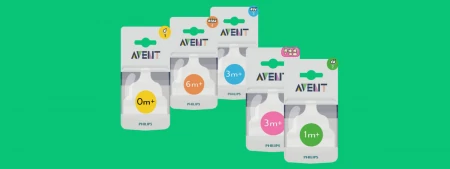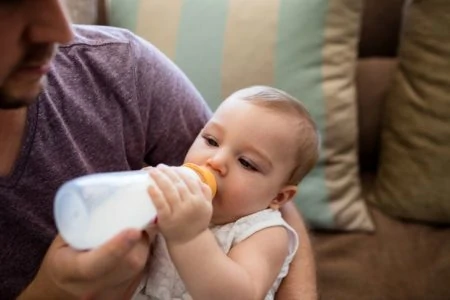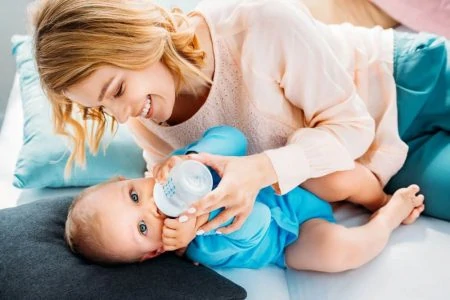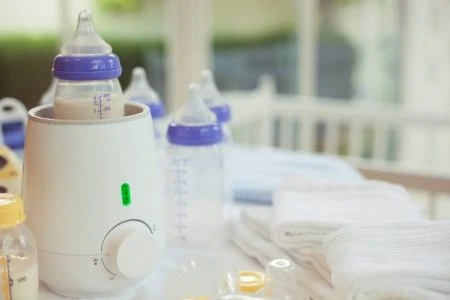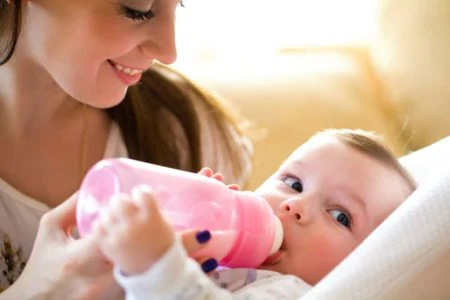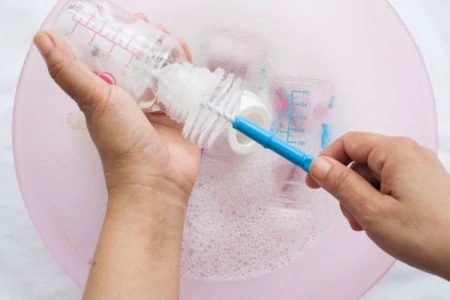Picking the right Philips Avent nipple size matters more than most of us realize. Too slow and baby works hard, gets fussy, and gives up. Too fast and milk floods their mouth, leaks, and can lead to gassiness.
I’ve been the new parent who didn’t know nipple sizes even existed. Once I matched the flow to my baby’s stage, bottle sessions got calmer and feeds were smoother. Use this guide to quickly find the Avent nipple that fits your baby’s age, feeding style, and pace.
Key Takeaways
- Match Flow To Stage: Use slower flows for newborns and faster flows as baby’s sucking strength and coordination improve.
- Age Is A Guide, Not A Rule: Watch baby’s cues—leaking milk, gulping, frustration, or super short/long feeds signal the flow is off.
- Change When Baby Tells You: If baby is impatient or sucking hard with little progress, try the next flow; if feeding seems rushed or messy, go slower.
Avent Nipple Sizes By Age
These are the Avent nipple sizes we recommend by each age group:
| Avent Nipple Size | Baby Age | Ideal For |
|---|---|---|
| First Flow Nipple | 0-1 Month | Preemies & Newborns |
| Newborn Nipple | 0-3 Months | Newborns (0-1M) & Breastfed Babies (0-3M) |
| Slow Flow Nipple | 1-3 Months | Newborns (1-3M) & Breastfed Babies (3M+) |
| Medium Flow Nipple | 3-6 Months | Babies (3M+) |
| Variable Flow Nipple | 3+ Months | Different Flow Rates With One Nipple |
| Fast Flow Nipple | 6+ Months | Babies (6M+) |
All age ranges are guidelines. Follow your baby’s cues first.
Can’t I Just Use One Size Nipple?
I once wondered the same thing. My baby was clearly hungry, but feedings were a battle even though he was sucking hard. A friend suggested trying a different flow—and everything clicked.
Different flows exist because baby feeding skills change quickly. Too slow creates frustration and long, tiring feeds. Too fast can feel like a pour, causing coughing, leaking, and extra spit-up.
The Philips Avent Natural bottle pairs features that help babies feed comfortably.
Here’s what parents tend to like:
- BPA-Free: Safe materials for everyday use and easy cleaning.
- Wide Neck: Simple to fill, assemble, and scrub by hand.
- Breast-Shaped Nipple: Encourages a natural latch and smooth switching with breast.
- Anti-Colic Venting: Designed to reduce swallowed air and gas.
What Size Nipple Should I Use?
Use these quick rules as a starting point, then adjust based on baby’s cues:
- 0–1 Month: First Flow or Newborn flow with a very slow rate for preemies and brand-new babies.
- 1–3 Months: Slow Flow to balance effort and intake for growing suck strength.
- 3–6 Months: Medium Flow as baby becomes more efficient at feeding.
- 6+ Months: Fast Flow for older babies who handle stronger flows without leaking or coughing.
- Thicker Liquids: Variable Flow (Y-cut) for thicker formulas or doctor-directed thickening.
When Do I Change Nipple Sizes?
If your baby is feeding comfortably, finishing bottles at a steady pace, and not leaking or coughing, you can stay with your current size.
Watch for these signs the flow may be too slow:
- Long Feeds: Consistently taking much more than 20–30 minutes per bottle.
- Frustration: Working hard, squirming, or dozing off before finishing.
- Collapsing Nipple: Nipple pinches flat often as baby sucks.
And these signs the flow may be too fast:
- Leaking Milk: Milk dribbling from the corners of the mouth.
- Gulping/Coughing: Struggling to coordinate suck–swallow–breathe.
- Very Short Feeds: Drains the bottle unusually fast and seems gassy afterward.
If you move up and see more spit-up or discomfort, drop back down and try paced bottle feeding for better control.
Natural, Natural Response, And Anti-Colic Compatibility
Avent nipples are not universally cross-compatible across all Avent ranges. Natural and Natural Response nipples fit within the Natural family of bottles, while Anti-colic/Classic+ nipples are designed for Anti-colic bottles. Check your bottle range and match the nipple from the same family for the best fit and performance.
Care And Replacement Tips
A few simple habits keep milk flowing correctly and safely:
- Inspect Often: Replace nipples every 2–3 months, or sooner if sticky, swollen, cracked, or thinning.
- Clean Thoroughly: Wash in warm soapy water and sterilize as needed; ensure the vent is clear.
- Store Dry: Let parts air-dry fully to prevent residue build-up that can alter flow.
- Right Assembly: Seat the nipple properly in the ring to prevent leaks and collapsing.
How To Check Flow At Home
A quick drip test helps you spot a flow that’s too fast:
- Flip And Watch: Fill the bottle, invert it, and observe; you want steady drops, not a continuous stream.
- Compare Feeds: Most babies do well finishing a typical bottle in about 10–20 minutes without leaking or gulping.
FAQs
Many parents have questions about Avent nipple sizes and flow. Here are the most common ones answered.
The Bottom Line
Pay attention to your baby’s cues and pick a nipple that matches their pace—steady drips, a comfortable latch, and calm, consistent feeds are your green lights. If something feels off, try a different flow or adjust technique with paced feeding, and consider the best baby bottles to keep milk moving smoothly.
Enjoy the snuggles and those quiet bottle moments while they last—before long, they’ll be reaching for sippy cups and you’ll miss these days!
